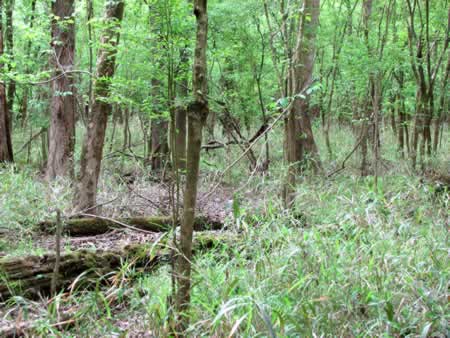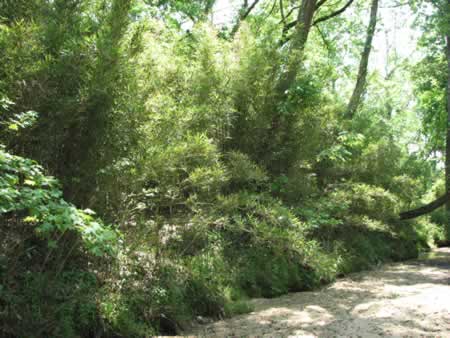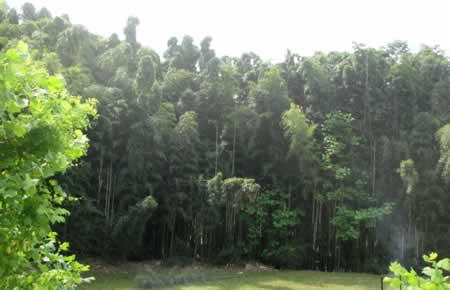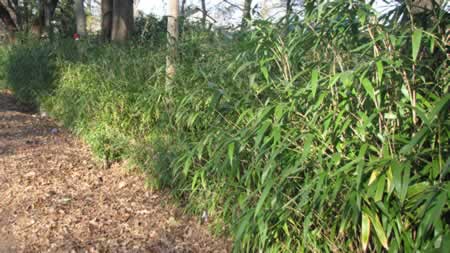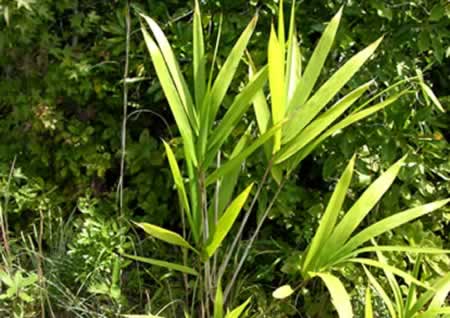Identifying Native Bamboos
by Margaret C. Cirtain*
Reprinted from the Winter 2010 Journal of the South Carolina Native Plant Society, and used by permission.
To see pictures or additional information about a particular plant, click its name.
The bamboos native to the southeastern United States are Arundinaria species (grass family, Poaceae); A. gigantea (river or giant cane), A. tecta (switch cane), and A. appalachiana (hill cane).
They are unique globally as the only temperate native bamboos in this hemisphere.
Rarely found in urban areas, they are most often located in rural areas with infrequent to no disturbance, for example along stream banks and field and fence edges. They are also often understory plants in forested landscapes, such as in Congaree National Park (Figure 1).
Historically, native bamboos formed extensive canebrakes, often stretching for miles and so dense that early travelers and explorers would detour around them. Using these canebrakes as habitat, many animals foraged and nested within the thick, protective cane stands. The diversity of canebrake dwellers was large, from many invertebrate species including butterflies and moths, to avian species (Swainson's warbler), reptiles (canebrake rattler), and mammals (black bear, swamp rabbit).
The native bamboo canebrake is now an endangered ecosystem, having declined by 98% from its former extent. The loss of canebrakes has had a negative impact on these faunal species, with some being extirpated or extinct. Additionally, ecosystem services provided by canebrakes have been drastically reduced. Researchers have found that river cane impacts two critical ecosystem services, 1) improving water quality contaminated by agricultural runoff and 2) reducing erosion on stream banks and road sides (Figure 2). This loss also had a negative impact on Native American cultures that relied heavily on cane for artisan crafts, basketry being one.
While many of the bamboos found in the southeastern United States are invasive non-native species, they may be distinguished from the native species fairly readily.
One of the most aggressive non-native species is golden bamboo, Phyllostachys aurea. This species is found along the Broad River in Columbia, SC. The stand shown in Figure 3 is typical of those found in the landscape across much of the United States.
Figure 4 shows another exotic Phyllostachys species, P. makinoi. Golden bamboo, as well as other bamboos in the genus Phyllostachys, were introduced as ornamental plantings as early as the mid-1800's throughout the US. Another common introduced ornamental was Pseudosasa japonica, or arrow bamboo (Figure 5).
Differences in distribution and vegetative characteristics help to distinguish among Arundinaria species and from non-native species. Typically river cane is more widely distributed in the southeastern US, switch cane in coastal plains and lower elevations, and hill cane in higher elevations (Appalachian Mountain region).
The morphological characteristics of the bamboos are unique. The underground system is primarily composed of segmented rhizomes, with roots extending from the rhizome nodes.
Bamboos are divided into two rhizomal types, pachymorph (or clumping), and leptomorph (or running). The aboveground culm and branches are composed of segmented components consisting of solid nodes and hollow internodes.
Monopodial branching (one main axis with secondary branches arising from it) develops from axillary buds at the nodes, on alternating positions along the culm. Bamboo bud or branch grouping at the node is called a branch complement.
The number and pattern of the branches composing the branch complement (typically at mid-culm) is a useful means of species identification.
There are two types of bamboo leaves, culm and foliage. The culm leaves form protective sheaths around the culm; the primary function of foliage leaves is photosynthesis.
Bamboos rarely flower and produce seed, but primarily propagate vegetatively. It has been estimated that Arundinaria species flower at 20 - 30 year intervals (Figure 6) and seed is often not viable.
All three Arundinaria species have leptomorphic rhizomes differing only in presence (switch cane and sometimes in hill cane) or absence of air canals (river cane).
River cane culms are generally taller than the other two species with a height from 2 to 8 meters and a slightly larger culm diameter.
The branch complement characteristic for the Arundinaria spp. is one of the most useful in not only distinguishing among the three species, but from other bamboos as well (Table 1). All three species exhibit multiple branch complements, in that 3 - 5 primary branches grow from a single node. They differ in the number of unexpanded basal internodes that appear like scales at the base of the primary branches.
Foliage is another distinguishing characteristic among the three species with hill cane having papery, deciduous foliage leaves while switch cane and river cane have leathery, persistent foliage leaves.
* Margaret Cirtain is a member of the Department of Biological Sciences at the University of South Carolina. Photos courtesy of the author, unless otherwise noted.
Additional information can be obtained from two excellent sources: American Bamboos by E. J. Judziewicz, L. G. Clark, X. Londono, and M. J. Stern; and Bamboo for Gardens by T. J. Meredith.
Dichotomous Key
for identification of ARUNDINARIA Michx.
Lynn G. Clark and J.K. Triplett
1. Primary branches with 0-1 compressed basal internodes; culm internodes usually sulcate; culm leaves deciduous ... A. gigantea
1. Primary branches with 2-5 compressed basal internodes; culm internodes usually terete; culm leaves persistent to tardily deciduous ... 2
2. Foliage blades coriaceous, persistent, abaxial surfaces densely pubescent or glabrous, strongly cross veined; primary branches usually longer than 50 cm, basal nodes developing secondary branches; topknot blades 20-30 cm long ... A. tecta
2. Foliage blades chartaceous, deciduous, abaxial surfaces pilose or glabrous, weakly cross veined; primary branches usually shorter than 35 cm, basal nodes not developing secondary branches; topknot blades 9-22.5 cm long ... A. appalachiana
Arundinaria gigantea (Walter) Muhl. (River Cane, Giant Cane)
Rhizomes normally remaining horizontal, sometimes hollow-centered, air canals absent.
Culms 2-8 m tall, to 3 cm thick; internodes typically sulcate distal to the branches.
Culm leaves deciduous; sheaths 9-15 cm; fimbriae 2.2-7 mm; blades 1.5-3.5 cm.
Topknots of 6-8 leaves; blades 16-24 cm long, 2-3.2 cm wide, lanceolate to ovate-lanceolate.
Primary branches to 25 cm, erect or nearly so, with 0-1 compressed basal internodes, lower elongated internodes flattened in cross section.
Foliage leaves: abaxial ligules usually ciliate, sometimes glabrous; blades subcoriaceous, persistent, evergreen, 8-15 cm long, 0.8-1.3 cm wide, bases rounded, abaxial surfaces glabrous or pubescent, strongly cross veined, adaxial surfaces glabrous or almost so.
Spikelets 4-7 cm, greenish or brownish, with 8-12 florets.
Glumes unequal, glabrous or pubescent, lowest glumes obtuse to acuminate or absent; lemmas 1.2-2 cm, usually appressed-hirsute to canescent, sometimes pubescent only towards the base and margins.
Caryopses oblong, beaked, without a style branch below the beaks. 2n = 48.
Arundinaria gigantea forms extensive colonies in low woods, moist ground, and along river banks. It was once widespread in the southeastern United States, but cultivation, burning, and overgrazing have destroyed many stands.
Arundinaria tecta (Walter) Muhl. (Switch Cane)
Rhizomes normally horizontal for only a short distance before turning up to form a culm, hollow-centered, air canals present.
Culms usually shorter than 2.5 m tall, to 2 cm thick; internodes terete in the vegetative parts.
Culm leaves persistent to tardily deciduous; sheaths 11-18 cm; fimbriae 1.5-8.5 mm; blades 2.5-4 cm.
Topknots of 9-12 leaves; blades 20-30 cm long, 1.8-3.2 cm wide, lanceolate to ovate-lanceolate.
Primary branches usually 50+ cm, basally erect and distally arcuate, terete, with 3-4 compressed basal internodes, basal nodes developing secondary branches, lower elongated internodes terete in cross section.
Foliage leaves: abaxial ligules fimbriate to lacerate, sometimes ciliate; blades 7-23 cm long, 1-2 cm wide, coriaceous, persistent, evergreen, bases rounded, abaxial surfaces densely pubescent or glabrous, strongly cross veined, adaxial surfaces pubescent.
Spikelets 3-5 cm, with 6-12 florets, the first occasionally sterile.
Glumes unequal, glabrous or pubescent; lowest glume obtuse to acuminate or absent; lemmas 1.2-2 cm, glabrous or nearly so.
Caryopses oblong, beaked, a rudimentary hooked style branch present below the beak. 2n = unknown.
Arundinaria tecta grows in swampy woods, moist pine barrens, live oak woods, and along the sandy margins of streams, preferring moister sites than A. gigantea. It grows only on the coastal plain of the southeastern United States.
Arundinaria appalachiana Triplett, Weakley & L.G. Clark (Hill Cane)
Rhizomes normally horizontal for only a short distance before turning up to form a culm, sometimes hollow-centered, air canals sometimes present.
Culms 0.5-1 (1.8) m tall, 0.2-0.6 cm thick; internodes terete.
Culm leaves persistent to tardily deciduous; sheaths 5.5-11 cm; fimbriae 1-4.6 mm; blades 0.8-1.4 cm.
Topknots of 6-12 leaves; blades 9-22.5 cm long, 1.4-2.8 cm wide, linear, linear-lanceolate, or ovate-lanceolate.
Primary branches usually shorter than 35 cm, erect, terete, with 2-5 compressed basal internodes, basal nodes not developing secondary branches.
Foliage leaves: abaxial ligules glabrous or ciliate, fimbriate or lacerate; blades 5-20 cm long, 0.8-2 cm wide, chartaceous, deciduous, bases rounded, abaxial surfaces pilose or glabrous, weakly cross veined, adaxial surfaces pilose.
Spikelets 3-5.5 cm, usually somewhat reddish purple, with 5-8 florets. 2n = unknown.
Arundinaria appalachiana grows on moist to dry slopes and in seeps. It is restricted to the southern Appalachians and upper piedmont.
Definitions:
Rhizome — a characteristically horizontal stem of a plant that is usually found underground, often sending out roots and shoots from its nodes. Rhizomes may also be referred to as creeping rootstalks, or rootstocks.
Culm — the aerial stems of grasses and sedges.
Sulcate — having deep, parallel furrows or grooves.
Chartaceous — having a thin papery appearance.
Fimbria (plural: fimbriae) — a fringe-like structure.
Abaxial — the abaxial surface of a leaf is the underside or side facing away from the stem.
Adaxial — the adaxial surface of a leaf is the upper side or side facing toward the stem.
Coriaceous — having a leathery texture
Topknot — see Figure 7.
TABLE 1: Morphological comparison
of Arundinaria appalachiana, A. tecta, and A. gigantea
| A. appalachiana | A. tecta | A. gigantea | |
| Rhizome air canals |
 sometimes present |
 present |
 absent |
| Rhizomes | horizontal short distance before turning up to form a culm; hollow centered |
horizontal short distance before turning up to form a culm; hollow centered |
normally remains horizontal; sometimes hollow-centered |
|
|
|||
| Culm height |
0.5 - 1 m | < 2.5 m | 2 - 8 m |
| Culm diameter |
0.2 - 0.6 cm | ~ 2 cm | ~ 3 cm |
| Culm internode |
 round or flattened |
 round or flattened |
 sulcate or round |
|
|
|||
| Culm leaf duration |
persistent | persistent | deciduous |
| Culm leaf auricles (midculm) |
 absent or weak |
 often strongly developed |
 often strongly developed |
|
|
|||
| Topknot leaf blade length |
9-22.5 cm | 20-30 cm | 16-24 cm |
|
|
|||
| Midculm branch complement (1° branch base) |
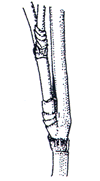 2-5 unexpanded basal internodes |
 2-4 unexpanded basal internodes |
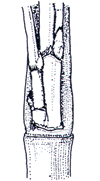 0-1 unexpanded basal internodes |
|
|
|||
| 1° branch length | 7-33 cm | Usually > 50 cm | 15-25 cm |
|
|
|||
| Foliage leaf pubescence |
 sparse long hairs, or smooth |
 dense short hairs, or smooth |
 dense short hairs, or smooth |
| Foliage leaf duration |
deciduous | persistent | persistent |
| Foliage leaf texture |
papery | leathery | somewhat leathery |
| Foliage leaf abaxial tessellation |
weakly tessellate | strongly tessellate | strongly tessellate |
|
|
|||
| Distribution | Appalachian Mountains: ne. AL, n. GA, sw. NC, sw. SC and se. TN |
Coastal Plain of southeastern US: e. MD to FL and s. MS (LA?) |
Widespread in southeastern US: s. DE, s. IL, south to FL and west to e. TX |
|
|
|||
| Chart courtesy of Jimmy K. Triplett, Ph.D., Post Doctoral Fellow, Department of Biology University of Missouri, St. Louis | |||

